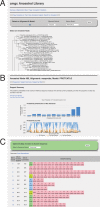PhyloBot: A Web Portal for Automated Phylogenetics, Ancestral Sequence Reconstruction, and Exploration of Mutational Trajectories
- PMID: 27472806
- PMCID: PMC4966924
- DOI: 10.1371/journal.pcbi.1004976
PhyloBot: A Web Portal for Automated Phylogenetics, Ancestral Sequence Reconstruction, and Exploration of Mutational Trajectories
Abstract
The method of phylogenetic ancestral sequence reconstruction is a powerful approach for studying evolutionary relationships among protein sequence, structure, and function. In particular, this approach allows investigators to (1) reconstruct and "resurrect" (that is, synthesize in vivo or in vitro) extinct proteins to study how they differ from modern proteins, (2) identify key amino acid changes that, over evolutionary timescales, have altered the function of the protein, and (3) order historical events in the evolution of protein function. Widespread use of this approach has been slow among molecular biologists, in part because the methods require significant computational expertise. Here we present PhyloBot, a web-based software tool that makes ancestral sequence reconstruction easy. Designed for non-experts, it integrates all the necessary software into a single user interface. Additionally, PhyloBot provides interactive tools to explore evolutionary trajectories between ancestors, enabling the rapid generation of hypotheses that can be tested using genetic or biochemical approaches. Early versions of this software were used in previous studies to discover genetic mechanisms underlying the functions of diverse protein families, including V-ATPase ion pumps, DNA-binding transcription regulators, and serine/threonine protein kinases. PhyloBot runs in a web browser, and is available at the following URL: http://www.phylobot.com. The software is implemented in Python using the Django web framework, and runs on elastic cloud computing resources from Amazon Web Services. Users can create and submit jobs on our free server (at the URL listed above), or use our open-source code to launch their own PhyloBot server.
Conflict of interest statement
The authors have declared that no competing interests exist.
Figures





Similar articles
-
FireProtASR: A Web Server for Fully Automated Ancestral Sequence Reconstruction.Brief Bioinform. 2021 Jul 20;22(4):bbaa337. doi: 10.1093/bib/bbaa337. Brief Bioinform. 2021. PMID: 33346815 Free PMC article.
-
Evolutionary Sequence Analysis and Visualization with Wasabi.Methods Mol Biol. 2021;2231:225-240. doi: 10.1007/978-1-0716-1036-7_14. Methods Mol Biol. 2021. PMID: 33289896
-
Phylemon: a suite of web tools for molecular evolution, phylogenetics and phylogenomics.Nucleic Acids Res. 2007 Jul;35(Web Server issue):W38-42. doi: 10.1093/nar/gkm224. Epub 2007 Apr 22. Nucleic Acids Res. 2007. PMID: 17452346 Free PMC article.
-
Phylogenetics by likelihood: evolutionary modeling as a tool for understanding the genome.J Biomed Inform. 2006 Feb;39(1):51-61. doi: 10.1016/j.jbi.2005.08.003. Epub 2005 Sep 15. J Biomed Inform. 2006. PMID: 16226061 Review.
-
Molecular Phylogenetics: Concepts for a Newcomer.Adv Biochem Eng Biotechnol. 2017;160:185-196. doi: 10.1007/10_2016_49. Adv Biochem Eng Biotechnol. 2017. PMID: 27783136 Review.
Cited by
-
Conservation of Structure and Immune Antagonist Functions of Filoviral VP35 Homologs Present in Microbat Genomes.Cell Rep. 2018 Jul 24;24(4):861-872.e6. doi: 10.1016/j.celrep.2018.06.045. Cell Rep. 2018. PMID: 30044983 Free PMC article.
-
Resurrecting ancestral genes in bacteria to interpret ancient biosignatures.Philos Trans A Math Phys Eng Sci. 2017 Dec 28;375(2109):20160352. doi: 10.1098/rsta.2016.0352. Philos Trans A Math Phys Eng Sci. 2017. PMID: 29133450 Free PMC article.
-
Diversification of DNA binding specificities enabled SREBP transcription regulators to expand the repertoire of cellular functions that they govern in fungi.PLoS Genet. 2018 Dec 31;14(12):e1007884. doi: 10.1371/journal.pgen.1007884. eCollection 2018 Dec. PLoS Genet. 2018. PMID: 30596634 Free PMC article.
-
Crystal structure of phosphoribulokinase from Synechococcus sp. strain PCC 6301.Acta Crystallogr F Struct Biol Commun. 2019 Apr 1;75(Pt 4):278-289. doi: 10.1107/S2053230X19002693. Epub 2019 Apr 2. Acta Crystallogr F Struct Biol Commun. 2019. PMID: 30950829 Free PMC article.
-
Resurrecting Enzymes by Ancestral Sequence Reconstruction.Methods Mol Biol. 2022;2397:111-136. doi: 10.1007/978-1-0716-1826-4_7. Methods Mol Biol. 2022. PMID: 34813062
References
Publication types
MeSH terms
Substances
Grants and funding
LinkOut - more resources
Full Text Sources
Other Literature Sources

